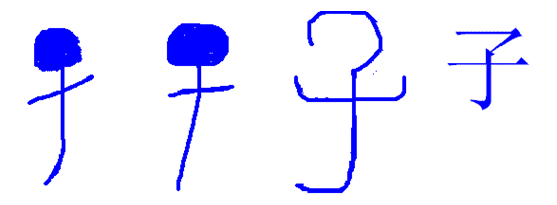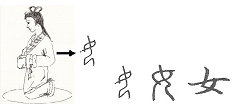Learning Chinese Characters through China’s history and culture
I often hear students say that Chinese characters seem to be overwhelming because they are so varied and some of them contain “numerous” stokes. As most learning requires effective ways, learning Chinese characters has its unique way as well.
Besides the pictographic characteristics of Chinese characters (as clarified in “Chinese characters as a form of visual art”), some Chinese characters also indicate the history and culture aspect of China. If you are learning Chinese characters through the stories about Chinese culture and history, it would make the learning more interesting and rewarding. Let’s have a look at the following examples.
The character “子” is a pictographic character (see picture 2.1.). In ancient times, the character “ ” means “children” when it is a radical of a character or “son” when it is a character by itself. The character looks like a baby with a big head while holding up two hands. The character has developed over the time but its modern version still holds some pictographic characteristics.
” means “children” when it is a radical of a character or “son” when it is a character by itself. The character looks like a baby with a big head while holding up two hands. The character has developed over the time but its modern version still holds some pictographic characteristics.

Picture 2.1. the development of Chinese character “子”
The character “女” is more than a pictographic Chinese character (see picture 2.2.). The original version of the Chinese character “女” (meaning female) looks like a lady with both her legs kneeled down. It was created to mean that women in ancient China usually stay at home waiting for either her father (before marriage) or her husband (after marriage) to come back.
This character “ ” (meaning female) also looks like a servant because of its unique posture. This indicates that ancient China is a male-dominate society and women are subordinate to males. In ancient times, Chinese women neither go for work nor go to schools, and the most important work for them is to take care of their husbands and children. In modern times, Chinese women not only receive higher education but also go for work, but they still regard family lives as the most important things in their lives.
” (meaning female) also looks like a servant because of its unique posture. This indicates that ancient China is a male-dominate society and women are subordinate to males. In ancient times, Chinese women neither go for work nor go to schools, and the most important work for them is to take care of their husbands and children. In modern times, Chinese women not only receive higher education but also go for work, but they still regard family lives as the most important things in their lives.

Picture 2.2. the development of Chinese character “女”
When we combine the above two characters (女+子,see picture 2.2. and picture 2.1.) together, we will have the character “好” (Hǎo, meaning “good” ). The character “好” is created with the meaning that it is a good thing when a woman has a child. It indicates that Chinese people pay significant attention of having offspring. There is a Chinese saying goes like this; there are three forms of unfilial conduct of which the worst is to have no descendants.
Anne Ma
Mandarin Language Consultant
Some stories about our Japanese Courses
Hi everyone, 皆さん、今日は。
Our Beginners 1 and Beginners 2 had the written (and writing) tests in their final week of the courses. The majority of the students prepared and responded well. Especially the results of the latter group were all pleasing or excellent. As for other class activities, apart from those with the regular textbooks and CDs, I showed episodes from the long series of “Japanese for Beginners” in most of the lessons with a bit of revision. The topics were: asking for directions, obtaining what you want in shopping, introducing yourself, asking time, etc. Each episode was useful, effective, intelligent, cultural and fun to watch.
In the JLPT N2, apart from working with the books/exercises of the Test, we read, comprehended and commented for some intelligent or informative articles from Japanese newspapers. One was an article of an executive of Misawa Homes Co. Ltd (Asahi newspaper, 17.9.11) about the importance of teaching (his) children to be creative, self sufficient, independent by developing survival skills that esp. for domestic needs, e.g. cooking, fixing bikes, sowing. He wants teach for/as his value since his father had taught him in his childhood.
Other article (Asahi newspaper, 17.9), which I showed to other classes too, reported about Japanese multi-nationals’ new economic activities around the world. The reporter wrote the article at International Motor Show in Germany. Three Japanese multi-nationals that produce textile and industrial fibers (as part of their products), i.e. Tore, Teijin and Mitsubishi-reiyon, are taking the top three in the global market for the production of fiber carbon being used for transport related industries (i.e. automobiles and aircrafts in particular). Their total share takes one forth of the world’s market. Companies that use the above carbon fiber include BMW, VW, US airlines, French Airbus and German Daimler. According to the report, use of carbon fiber greatly reduces the weight of vehicles/aircrafts, energy needed (fuel, electricity etc) and costs/time compared to past practices and carbon fiber is 10 times tougher than steel for such use.
For practice of speaking telephone numbers etc, I used the big advertisement page (Asahi newspaper) of a movie “1911” played by Jackie Chan that was shown at many major cinemas around Japan.
Also, I showed the big advertisement page of “Kiite tanoshimu Nihon no Meisaku” (Asahi newspaper, 11.9). (Company: U-CAN, Tokyo) It talks and shows about 16 CDs of narratives of well known works of many Japanese classical and highly known novelists and poets. The dates of those go back to 1887, including Soseki Natsume, Higuchi ichiyo. Narrated by 10 experts.
When our Beginners 2 and Pre-Intermediate 1 started, I introduced Japanese traditional “matcha” (kind of beautiful green tea in tea bags) bought at an Asian food shop and gave a tea bag to each student for their later drinking at home. Also, I showed/informed about Japanese curry paste with a package, i.e the way to make Japanese curry & rice in a nutritious way with a great taste. And I showed the wrapping part of Japanese “natto” package (natto = brown fermented beans) and introduced my recipe that is mixing “natto” with salad (very healthy and refreshing) with a lot of salad, e.g. white radish, alfalfa, lettuce, raw egg and soy sauce. (Usually, in the past, there was/were student(s) in my classes who went to buy esp. curry paste and tried making curry paste after hearing my talk of the above! They liked the food they made/had.)
5.11.11
Japanese Teacher, Toshiko Jackson



Latest Comments